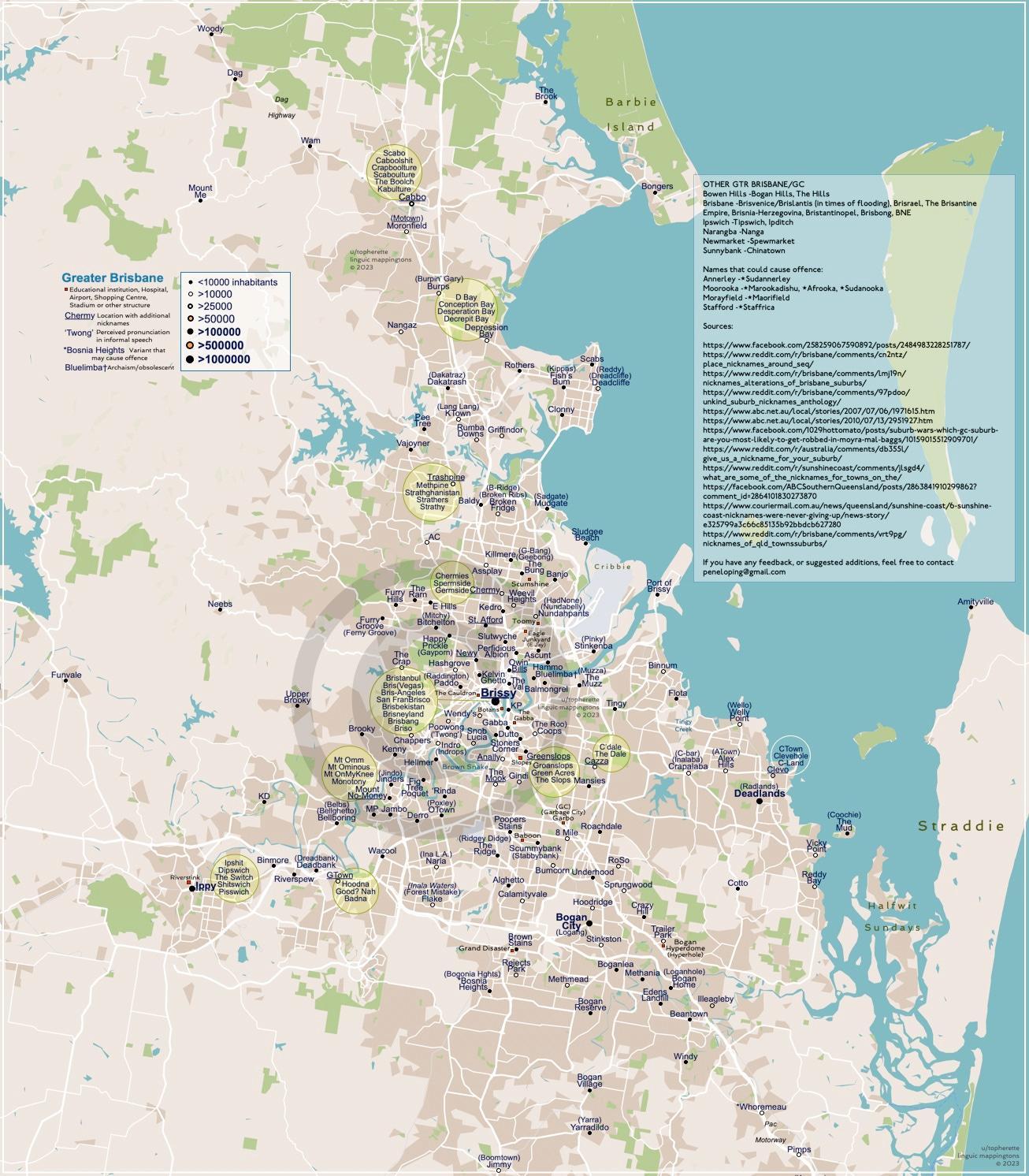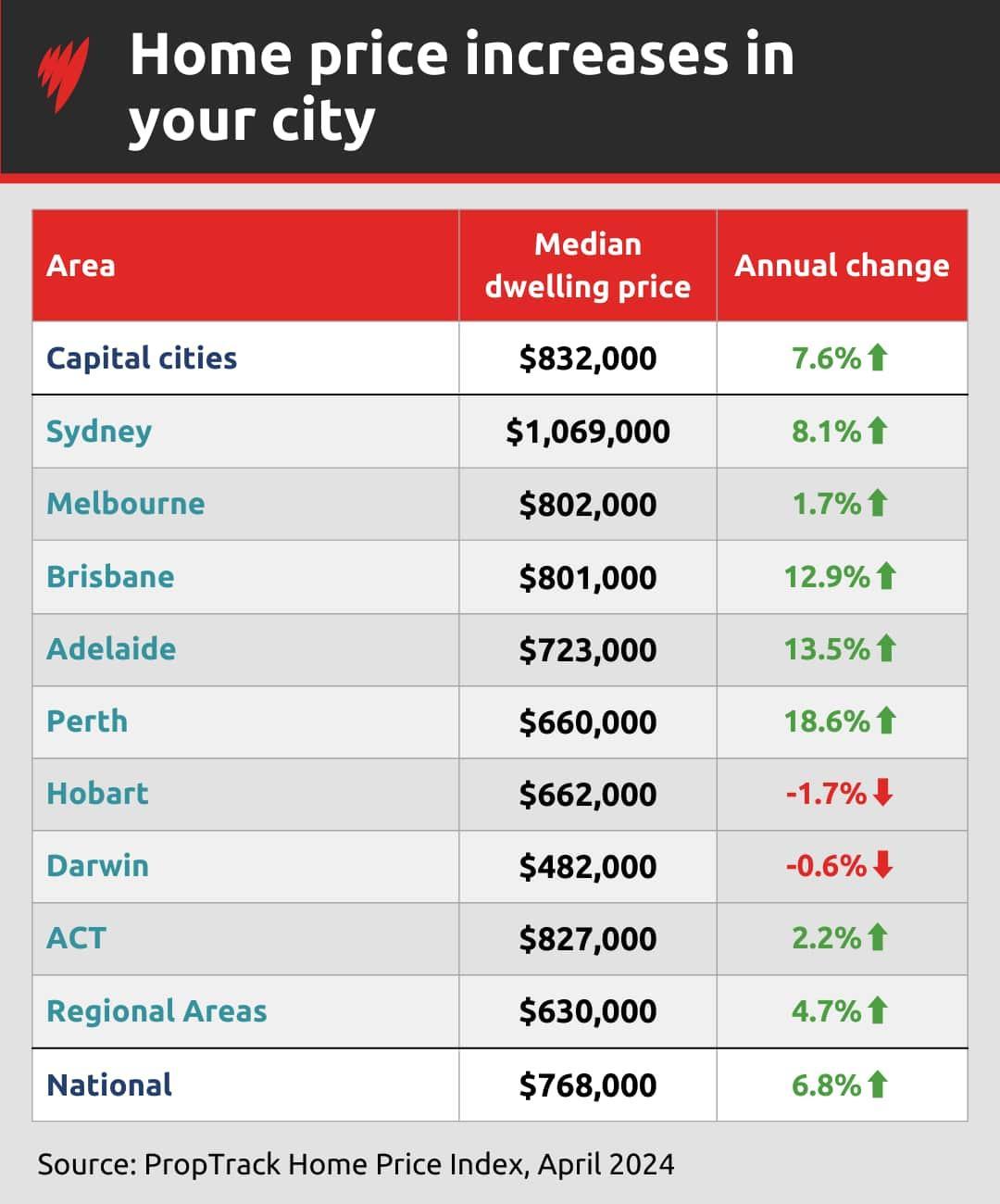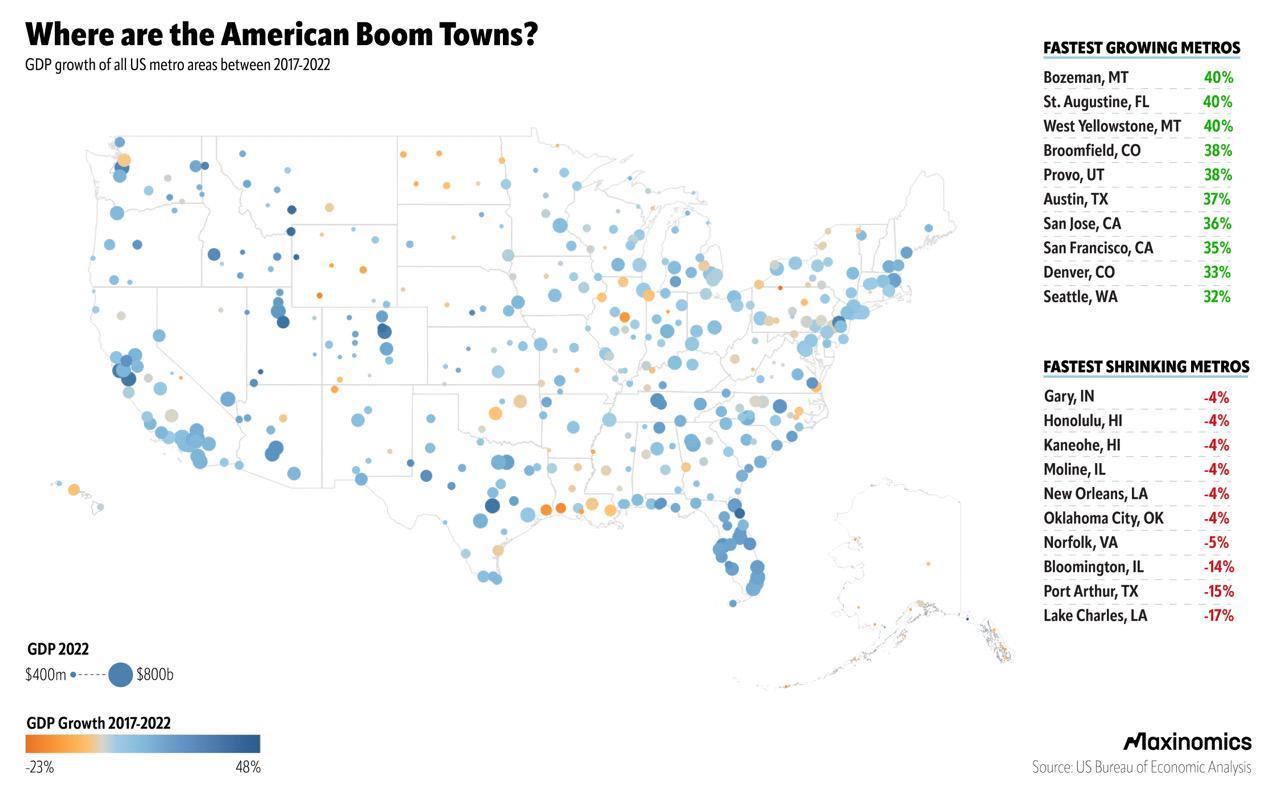The Next Boomtowns in Australia: Invest Here Before Everyone Else Does
In 2016, the Sunshine Coast was best known for its beaches and a laid-back lifestyle, a destination for retirees rather than a hub of economic ambition. By 2025, it’s projected to outpace most of Australia’s major cities in population growth, with a 12-16% surge driven by a combination of infrastructure investments, lifestyle migration, and a booming local economy. This transformation is not an isolated phenomenon. Across Australia, smaller cities and regional centers are quietly reshaping the nation’s urban hierarchy, fueled by shifting demographics, government policies, and the rise of remote work. Townsville, for instance, is on track for a staggering 25-30% growth, bolstered by its strategic position in Northern Australia’s economic corridor. These emerging boomtowns are not just growing—they are redefining what it means to live and invest outside the traditional powerhouses of Sydney and Melbourne. For those paying attention, the opportunities are as vast as the changes underway.
Understanding the Concept of Boomtowns
The evolution of boomtowns in Australia is increasingly tied to the interplay between infrastructure development and demographic shifts. A critical yet underexplored factor is the role of lifestyle migration—a phenomenon where individuals prioritize quality of life over traditional economic hubs. This trend is amplified by the rise of remote work, enabling professionals to relocate to regions like the Sunshine Coast or Townsville without sacrificing career opportunities.
One effective approach driving this transformation is targeted government investment in transport and digital infrastructure. For instance, the expansion of high-speed internet in regional areas has not only attracted tech-savvy professionals but also fostered local entrepreneurship. This aligns with findings from the Bowen Basin case studies, where infrastructure improvements catalyzed downstream economic activity, benefiting small businesses and non-mining sectors.
Moreover, the housing market dynamics in these regions reveal a nuanced challenge: balancing affordability with demand. Flexible zoning policies, as seen in Mackay, have proven effective in mitigating housing shortages while maintaining community cohesion.
Looking ahead, integrating urban planning with environmental sustainability could redefine the boomtown model. By embedding green spaces and renewable energy solutions, these regions can attract a new wave of eco-conscious migrants, ensuring long-term growth and resilience.
Historical Context and Current Trends
Australia’s boomtowns have historically been shaped by resource-driven economies, yet a pivotal shift is occurring as these towns diversify beyond mining. For example, the late 19th-century mineral boom established foundational settlements in Western Australia and Queensland, but these were often transient, tied to resource depletion. Today, regions like Townsville are leveraging their strategic location within Northern Australia’s economic corridor to foster sustainable growth through infrastructure and industry diversification.
A lesser-known yet critical factor influencing current trends is the integration of knowledge economies into regional centers. Universities and research hubs, such as the Monash University campus in regional Victoria, are anchoring talent and innovation in these areas. This approach not only mitigates the volatility of resource dependence but also attracts industries like advanced manufacturing and renewable energy.
Challenging the conventional wisdom that urban growth is inherently tied to proximity to major cities, these boomtowns demonstrate that targeted investments in connectivity—such as high-speed rail and digital infrastructure—can redefine regional competitiveness.
Looking forward, the interplay between education, technology, and environmental planning offers a framework for sustainable urbanization. By fostering ecosystems that balance economic opportunity with quality of life, these towns can serve as models for resilient regional development.
Key Economic Indicators of Boomtowns
Boomtowns in Australia exhibit a unique set of economic indicators that distinguish them from traditional urban centers. One standout metric is the disproportionate GDP contribution relative to population size. For instance, regional Australia, which includes emerging boomtowns, accounts for approximately 40% of the national economic output while employing only a third of the workforce. This efficiency highlights the economic dynamism of these regions.
Another critical indicator is the rate of infrastructure investment. Townsville, for example, has seen a surge in public and private funding, including the $193 million Port of Townsville expansion, which has catalyzed trade and logistics growth. Similarly, the Sunshine Coast’s investment in digital infrastructure, such as the international broadband submarine cable, has positioned it as a tech hub.
Contrary to misconceptions, housing affordability in boomtowns is not uniformly declining. Flexible zoning policies, like those in Mackay, have balanced demand with supply, maintaining relative affordability compared to metropolitan areas.
These indicators underscore the transformative potential of targeted investments and strategic planning, offering a blueprint for sustainable growth that challenges the dominance of traditional urban centers.
Image source: shittownsofaustralia.substack.com
Population Growth and Demographic Shifts
One of the most compelling drivers of population growth in boomtowns is lifestyle migration, where individuals prioritize quality of life over proximity to traditional economic hubs. This trend is amplified by the rise of remote work, enabling professionals to relocate without sacrificing career opportunities. For example, the Sunshine Coast has seen a surge in young families and mid-career professionals drawn by its coastal lifestyle and robust digital infrastructure, such as the international broadband submarine cable.
A lesser-known factor influencing demographic shifts is the role of non-resident workers. In regions like Townsville, fly-in/fly-out (FIFO) workers initially boost local economies but often create challenges in community cohesion and housing demand. Adaptive policies, such as those seen in Mackay, which integrate non-resident workers into long-term housing strategies, have proven effective in stabilizing these dynamics.
Interestingly, population growth in these areas often defies the urban-centric narrative. Coastal boomtowns are attracting migrants not just from metropolitan areas but also from other regional centers, creating a ripple effect of growth. This highlights the importance of tailored urban planning that balances infrastructure with environmental sustainability, ensuring these regions remain attractive and resilient.
Looking ahead, fostering inclusive communities and leveraging demographic diversity could redefine the growth trajectory of Australia’s emerging boomtowns.
Infrastructure Development and Government Initiatives
A pivotal yet underappreciated aspect of infrastructure development in boomtowns is the integration of multi-modal transport systems. By combining road, rail, and port infrastructure, regions like Townsville have amplified their economic potential. The $193 million Port of Townsville expansion, for instance, not only enhanced trade capacity but also created synergies with rail upgrades, reducing logistical bottlenecks and attracting industries reliant on efficient supply chains.
Government initiatives targeting digital infrastructure have also proven transformative. The Sunshine Coast’s international broadband submarine cable is a prime example, positioning the region as a tech hub and enabling local businesses to compete globally. This investment has catalyzed the growth of knowledge-based industries, diversifying the economy beyond traditional sectors.
A lesser-known but critical factor is the role of public-private partnerships (PPPs) in accelerating infrastructure delivery. In Mackay, PPPs have facilitated the development of mixed-use precincts, blending residential, commercial, and green spaces. This approach not only addresses housing demand but also fosters community cohesion and environmental sustainability.
Challenging the conventional focus on urban-centric growth, these initiatives demonstrate that targeted investments in connectivity and innovation can redefine regional competitiveness. Moving forward, integrating smart city technologies—such as IoT-enabled infrastructure—could further enhance efficiency and resilience, ensuring boomtowns remain at the forefront of sustainable development.
Identifying Potential Boomtowns in Australia
Identifying Australia’s next boomtowns requires a nuanced approach that goes beyond surface-level metrics like population growth. A key indicator is the rate of infrastructure investment relative to economic output. For instance, Townsville’s $193 million Port expansion has not only boosted trade but also attracted industries reliant on efficient logistics, positioning it as a critical node in Northern Australia’s economic corridor.
Another overlooked factor is the presence of knowledge hubs. Regional centers like Bendigo, with its Monash University campus, anchor talent and innovation, fostering industries such as advanced manufacturing and renewable energy. This contrasts with mining-dependent towns, which often face volatility tied to resource cycles.
Interestingly, housing market dynamics can also signal potential. Flexible zoning policies in Mackay have balanced affordability with demand, creating a stable environment for long-term growth.
Challenging the misconception that proximity to major cities is essential, these examples highlight how targeted investments in connectivity and education can redefine regional competitiveness. For investors, the lesson is clear: follow the infrastructure, but don’t overlook the knowledge economy.

Image source: sbs.com.au
Regional Centers and Outer Suburban Areas
The interplay between regional centers and their outer suburban areas is reshaping Australia’s urban landscape, offering a blueprint for sustainable growth. A critical factor driving this dynamic is the spillover effect—where economic and population growth in regional hubs extends into surrounding suburbs. For example, Geelong’s thriving construction sector has catalyzed development in nearby towns, creating a network of interconnected communities that share resources and infrastructure.
One lesser-known driver of this trend is the role of transport-oriented development (TOD). By aligning housing and commercial projects with public transport routes, regions like Newcastle have reduced commuting times while boosting property values in outer suburbs. This approach not only enhances accessibility but also attracts a diverse workforce, fostering economic resilience.
Challenging the notion that suburban sprawl dilutes regional growth, these areas often act as pressure valves for housing demand, offering affordable alternatives without sacrificing connectivity. Flexible zoning policies, as seen in Mackay, further amplify this effect by enabling mixed-use developments that integrate residential, commercial, and green spaces.
Looking ahead, leveraging smart city technologies—such as IoT-enabled transport systems—could strengthen these connections, ensuring that regional centers and their suburbs evolve as cohesive, sustainable ecosystems primed for long-term investment.
Resource-Driven Towns and Economic Diversification
A pivotal yet underexplored aspect of resource-driven towns is the integration of knowledge economies to mitigate the volatility of resource cycles. Unlike traditional mining towns that rely heavily on extractive industries, regions like Moranbah in Queensland have begun leveraging education and research partnerships to foster economic diversification. For instance, the establishment of vocational training centers tailored to renewable energy and advanced manufacturing has created a skilled workforce capable of supporting emerging industries.
One effective approach is the use of public-private partnerships (PPPs) to fund infrastructure that supports diversification. In the Pilbara region, collaboration between resource companies and local governments has led to the development of mixed-use precincts, blending industrial facilities with community amenities. This strategy not only attracts new businesses but also enhances liveability, reducing the reliance on transient FIFO workers.
A lesser-known factor influencing success is the role of adaptive governance. The Growth Management Group in Moranbah exemplifies this by coordinating stakeholders to align land use, housing, and infrastructure with long-term economic goals. This contrasts with the reactive planning often seen in resource towns, which exacerbates boom-bust cycles.
Looking forward, embedding circular economy principles—such as repurposing mining infrastructure for green energy projects—could redefine resource towns as hubs of innovation, ensuring resilience and sustained growth in a post-resource economy.
Investment Strategies for Emerging Boomtowns
Investing in emerging boomtowns requires a nuanced approach that balances short-term gains with long-term sustainability. A key strategy is to focus on infrastructure-led growth. For instance, Townsville’s $193 million Port expansion has not only boosted trade but also attracted logistics and manufacturing industries, creating a ripple effect across the local economy. Investors who align with such infrastructure projects can capitalize on the resulting economic dynamism.
Another overlooked opportunity lies in knowledge-driven industries. Regional hubs like Bendigo, anchored by Monash University, are fostering innovation in advanced manufacturing and renewable energy. These sectors offer stability compared to resource-dependent industries, making them attractive for long-term investment.
A common misconception is that housing markets in boomtowns are uniformly overheated. However, flexible zoning policies, as seen in Mackay, have maintained affordability while supporting demand. This creates opportunities for investors to develop mixed-use precincts that integrate residential, commercial, and green spaces.
By combining insights from infrastructure, education, and housing, investors can craft strategies that not only yield returns but also contribute to the sustainable growth of these thriving regions.
Early Investment Opportunities and Risks
One of the most promising yet complex opportunities in emerging boomtowns lies in transport-oriented development (TOD). By aligning investments with multi-modal transport hubs, such as those seen in Newcastle, investors can tap into projects that enhance connectivity while driving property value growth. For example, Newcastle’s integration of light rail with residential and commercial developments has reduced commuting times and attracted a diverse workforce, fostering long-term economic resilience.
However, a lesser-known risk in such ventures is the lag in infrastructure delivery. Delays in transport projects can lead to misaligned timelines for associated developments, straining investor returns. This highlights the importance of adaptive investment frameworks—strategies that account for phased project rollouts and allow for flexibility in capital allocation.
Another overlooked factor is the role of community engagement. Projects that fail to integrate local needs often face resistance, as seen in some mining towns where rapid development disrupted social cohesion. Investors can mitigate this by prioritizing mixed-use precincts that balance economic growth with liveability, as demonstrated in Mackay’s zoning policies.
Looking ahead, leveraging smart city technologies—such as IoT-enabled transport systems—can further de-risk TOD investments, ensuring efficiency and scalability. For investors, the key is to align with projects that not only promise returns but also contribute to sustainable urban ecosystems.
Case Studies of Successful Investments
A standout example of successful investment in emerging boomtowns is the Port of Townsville expansion. This $193 million project not only enhanced the port’s trade capacity but also catalyzed growth in logistics and manufacturing industries. The strategic integration of port upgrades with rail and road infrastructure created a seamless supply chain, attracting businesses reliant on efficient transport networks. This multi-modal approach demonstrates how aligning infrastructure investments with regional economic strengths can amplify returns.
A lesser-known but critical factor in this success was the use of public-private partnerships (PPPs). By leveraging private sector expertise and funding, the project accelerated timelines and ensured high-quality outcomes. This model also reduced the financial burden on local governments, enabling them to allocate resources to complementary initiatives, such as workforce development programs.
Interestingly, the ripple effects extended beyond economic metrics. The project spurred the development of mixed-use precincts, blending industrial facilities with residential and commercial spaces. This approach not only addressed housing demand but also fostered community cohesion, a challenge often overlooked in resource-driven towns.
Challenging conventional wisdom that infrastructure projects primarily benefit large corporations, the Townsville case highlights the importance of inclusive planning. By engaging local stakeholders early, the project balanced economic growth with liveability, ensuring long-term sustainability.
Looking forward, replicating this model in other boomtowns could unlock untapped potential. Investors should prioritize regions with strong PPP frameworks and focus on projects that integrate economic, social, and environmental objectives for holistic growth.
Challenges and Misconceptions in Boomtown Investments
Investing in boomtowns often appears as a straightforward path to high returns, but this perception masks significant challenges. A common misconception is that rapid growth guarantees sustained profitability. However, the cyclical nature of boomtown economies, particularly those tied to resource extraction, can lead to abrupt downturns. For instance, Western North Dakota’s oil boom saw skyrocketing housing demand, only to face a bust that left infrastructure underutilized and investors grappling with losses.
Another overlooked challenge is social disintegration. Rapid population influx strains local services, as seen in mining towns where crime rates and mental health issues surged (Kohrs, 1974). These disruptions can deter private investment, especially when governments fail to address infrastructure gaps.
Interestingly, community engagement emerges as a critical yet underutilized strategy. Mackay’s zoning policies, which integrated non-resident workers into long-term housing plans, highlight how inclusive planning can stabilize volatile markets.
Investors must adopt adaptive frameworks, balancing short-term gains with resilience against boom-bust cycles.
Image source: reddit.com
Common Misconceptions About Regional Growth
One persistent misconception about regional growth is the assumption that proximity to major cities is essential for success. While urban adjacency can offer advantages, emerging boomtowns like Townsville and the Sunshine Coast demonstrate that connectivity, not proximity, is the true driver of growth. Investments in high-speed internet, such as the Sunshine Coast’s international broadband submarine cable, have enabled these regions to attract tech-savvy professionals and foster knowledge-based industries, effectively bypassing the need for metropolitan dependence.
Another overlooked factor is the role of adaptive zoning policies. Flexible approaches, as seen in Mackay, have balanced housing affordability with demand, countering the narrative that regional growth inevitably leads to skyrocketing property prices. These policies also encourage mixed-use developments, integrating residential, commercial, and green spaces to enhance liveability.
Interestingly, the rise of lifestyle migration has further challenged traditional growth models. Professionals now prioritize quality of life over urban proximity, a trend amplified by remote work capabilities. This shift underscores the importance of aligning infrastructure investments with lifestyle amenities, such as green spaces and cultural hubs.
Looking ahead, regions that embrace smart city technologies and sustainable urban planning will redefine the benchmarks for regional growth, offering a blueprint for resilience and long-term prosperity.
Sustainability and Long-term Viability
A critical yet underexplored aspect of sustainability in boomtowns is the integration of circular economy principles. Unlike traditional linear models, which rely on resource extraction and disposal, circular systems emphasize reuse, recycling, and regeneration. For instance, in the Pilbara region, decommissioned mining infrastructure has been repurposed for renewable energy projects, such as solar farms, creating a dual benefit of reducing waste and fostering green energy production.
Another effective approach is embedding resilience planning into urban development. Adaptive governance frameworks, like those implemented in Moranbah, align land use, housing, and infrastructure with long-term economic and environmental goals. This ensures that boomtowns can weather economic downturns without compromising their liveability or growth potential.
A lesser-known but impactful factor is the role of ecosystem services. By preserving natural assets such as wetlands and forests, regions can mitigate environmental risks while enhancing community well-being. For example, the Sunshine Coast’s integration of green spaces into urban planning has attracted eco-conscious migrants and bolstered its reputation as a sustainable hub.
Challenging the conventional focus on short-term economic gains, these strategies highlight the importance of aligning growth with environmental stewardship. Moving forward, leveraging smart city technologies—such as IoT-enabled energy grids—can further enhance sustainability, ensuring that boomtowns remain viable and competitive in a rapidly evolving global economy.
Future Trends and Predictions for Australian Boomtowns
The next decade will see Australian boomtowns increasingly shaped by tech-driven urban ecosystems. Regions like the Sunshine Coast, already leveraging its international broadband submarine cable, are poised to integrate smart city technologies such as IoT-enabled infrastructure and AI-driven urban planning. These advancements will optimize resource use, reduce environmental impact, and enhance liveability.
A surprising trend is the rise of micro-industrial clusters. Townsville, for example, is fostering renewable energy hubs that combine advanced manufacturing with local research institutions. This model not only diversifies economies but also attracts global investment, challenging the misconception that regional growth is solely resource-dependent.
Additionally, climate adaptation strategies will redefine urban planning. Coastal boomtowns are embedding green infrastructure—like mangrove restoration—to combat rising sea levels, blending sustainability with resilience.
Looking ahead, the interplay of technology, environmental stewardship, and community-driven policies will position these regions as global exemplars of sustainable growth, offering investors unparalleled opportunities.
Impact of Climate Change and Technology
Climate change is reshaping the trajectory of Australian boomtowns, but technology is emerging as a powerful equalizer. One critical area is the integration of predictive analytics to mitigate climate risks. For instance, Townsville has adopted AI-driven models to forecast flood patterns, enabling proactive infrastructure planning and reducing economic disruptions. This approach exemplifies how data-driven insights can transform vulnerability into resilience.
A lesser-known yet pivotal factor is the role of renewable energy microgrids. In regions like the Pilbara, these systems are repurposing decommissioned mining sites into solar and wind energy hubs. By decentralizing energy production, boomtowns can reduce reliance on volatile external grids while fostering local job creation in green industries.
Challenging the misconception that climate adaptation is purely reactive, these towns are embedding climate-positive technologies into urban planning. For example, the Sunshine Coast’s use of IoT-enabled water management systems has optimized irrigation, conserving resources in increasingly arid conditions.
Looking forward, the convergence of climate adaptation and technology offers a blueprint for sustainable growth. By prioritizing innovations that align with environmental realities, boomtowns can not only withstand climate challenges but also position themselves as global leaders in resilient urban ecosystems.
Government Policies and Decentralization
A pivotal yet underexplored aspect of decentralization policies is the integration of place-based incentives to attract industries and talent to regional centers. Unlike blanket policies, these targeted approaches align economic incentives with the unique strengths of each boomtown. For example, Bendigo’s commitment to fostering a “creative city” has been bolstered by tax incentives for cultural industries, driving both economic diversification and community engagement.
A lesser-known but impactful factor is the role of regional governance frameworks. The establishment of Regional Development Australia (RDA) committees has enabled localized decision-making, ensuring that infrastructure investments and policy initiatives are tailored to the specific needs of each area. This contrasts with the one-size-fits-all strategies of the past, which often failed to account for regional disparities.
Challenging the conventional wisdom that decentralization is primarily about relocating government agencies, recent initiatives emphasize multi-sector collaboration. Public-private partnerships (PPPs) in Mackay, for instance, have successfully integrated housing, transport, and green spaces into cohesive urban ecosystems, creating a model for sustainable growth.
Looking ahead, decentralization policies must embrace adaptive governance and leverage digital tools like AI for real-time data analysis. By aligning incentives with regional strengths and fostering cross-sector collaboration, governments can unlock the full potential of boomtowns, ensuring they thrive as self-sustaining economic and social hubs.
FAQ
What are the key factors driving the rise of Australia’s next boomtowns?
The rise of Australia’s next boomtowns is driven by a synergy of factors, including strategic infrastructure investments like the $193 million Port of Townsville expansion, which enhances trade and logistics. Lifestyle migration, fueled by remote work and quality-of-life priorities, attracts professionals to regions like the Sunshine Coast. Government policies, such as place-based incentives and public-private partnerships, foster economic diversification in areas like Mackay. Additionally, the integration of knowledge hubs, such as Monash University campuses, anchors talent and innovation. These elements collectively redefine regional competitiveness, creating sustainable ecosystems that challenge the dominance of traditional metropolitan centers.
How do infrastructure investments influence economic growth in emerging regional centers?
Infrastructure investments act as catalysts for economic growth in emerging regional centers by enhancing connectivity, attracting industries, and fostering innovation. Projects like the $8.4 billion Inland Rail improve freight efficiency, while the Sunshine Coast’s international broadband submarine cable positions the region as a tech hub. Public-private partnerships, such as those in Mackay, integrate transport, housing, and green spaces, creating cohesive urban ecosystems. These investments not only boost local economies but also attract lifestyle migrants and businesses seeking affordable, well-connected locations. By aligning infrastructure with regional strengths, these centers become self-sustaining hubs, driving long-term economic resilience and diversification.
Which industries are thriving in Australia’s fastest-growing boomtowns and why?
Industries thriving in Australia’s fastest-growing boomtowns include renewable energy, advanced manufacturing, and technology-driven sectors. Townsville is emerging as a renewable energy hub, leveraging its strategic location and infrastructure like the Port of Townsville. The Sunshine Coast’s digital infrastructure, including its broadband submarine cable, supports tech startups and knowledge-based industries. AgTech and precision farming are flourishing in regions like Bendigo, driven by demand for sustainable practices and export opportunities. Additionally, flexible zoning policies in areas like Mackay enable mixed-use developments, fostering construction and real estate growth. These industries thrive due to targeted investments, innovation hubs, and lifestyle-driven migration trends.
What role does government policy play in shaping the future of regional Australian cities?
Government policy plays a pivotal role in shaping regional Australian cities through strategic initiatives like place-based incentives and infrastructure-led growth. Programs such as City and Regional Deals align federal, state, and local efforts to boost connectivity and economic diversification. In New South Wales, coordinated spatial planning integrates transport and housing, fostering sustainable development. Public-private partnerships, as seen in Mackay, accelerate urban renewal while balancing community needs. Additionally, policies supporting knowledge hubs, like Monash University campuses, anchor talent and innovation. By prioritizing tailored, region-specific strategies, government policies ensure these cities evolve into resilient, self-sustaining economic and social ecosystems.
How can investors identify high-potential opportunities in Australia’s emerging boomtowns?
Investors can identify high-potential opportunities in Australia’s emerging boomtowns by analyzing key indicators such as infrastructure investment, population growth, and economic diversification. Regions like Townsville, with its $193 million Port expansion, showcase the transformative impact of logistics and trade enhancements. Monitoring housing market dynamics, including vacancy rates and zoning policies, as seen in Mackay, reveals areas with balanced affordability and demand. Knowledge hubs, such as Monash University in Bendigo, signal innovation-driven growth. Additionally, tracking government incentives and public-private partnerships highlights regions primed for sustainable development. Combining these metrics ensures informed decisions in identifying thriving investment hotspots.








